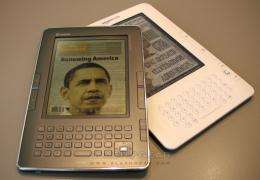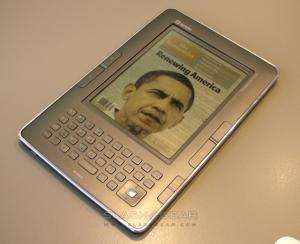November 20, 2009 weblog
Qualcomm's next e-book to use a mirasol display

(PhysOrg.com) -- Qualcomm subsidiary Mirasol is developing a new e-book reader with a color display that uses ambient light. The reader will be capable of displaying video smoothly, but the new features will have little impact on battery life.
The e-book is only at mock-up stage, but a working 5.7 inch mirasol display panel has been demonstrated. Several versions of the e-book are planned, such as models with or without touchscreen and with or without QWERTY keyboards. It is expected to have wireless connectivity. The mirasol display panel will have numerous applications.
The mirasol display uses an interferometric modulation technology. In this system a mirrored surface is overlaid with tiny flexible membranes that react to electrical charges. Ambient light is reflected off the mirror and back through the membranes, which refract the light. Specific wavelengths interfere with each other, creating colors. The membranes are bistable, which means they have two stable states. Once they display a color virtually no energy is required to maintain it, and energy is only required to change the color.
The low energy requirement means the battery will last much longer than a similar sized LCD (liquid crystal display) device, and the battery will only need recharging once a week instead of after a few hours. According to Jim Cathey, Vice President of Business Development, the energy consumption is 1 mW for a display the same size as an LCD requiring 240-500 mW.

The mirasol system also means there is no need for color filters, polarizing lenses or strong backlighting. The display is visible in direct sunlight, and since it relies on reflected light, the brighter the ambient light, the greater the resolution of the image.
The cost of the mirasol display is expected to be about the same as an LCD of similar size. Its lower energy consumption makes it "greener", and so does its lower toxicity.
The mirasol technology could be used for virtually any application that has a display panel and a battery. A mirasol display has already appeared in a mobile phone in China, and LG is developing its own phone with a mirasol display.
via Slashgear
© 2009 PhysOrg.com




















